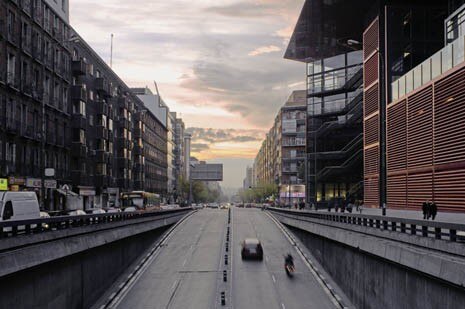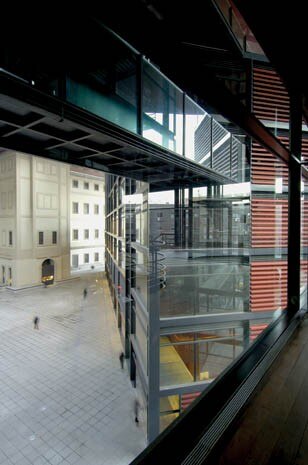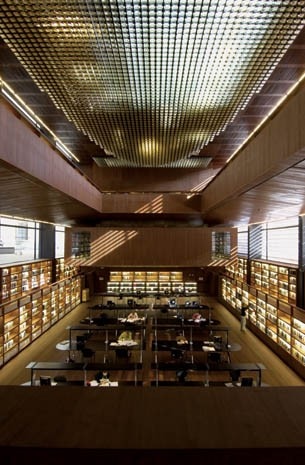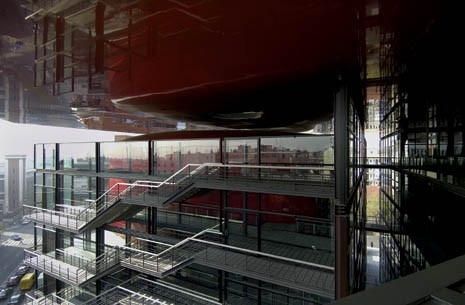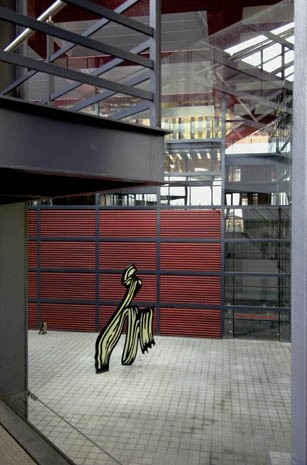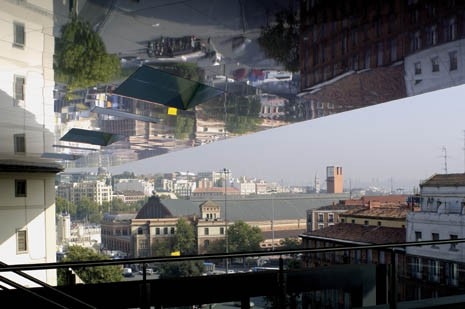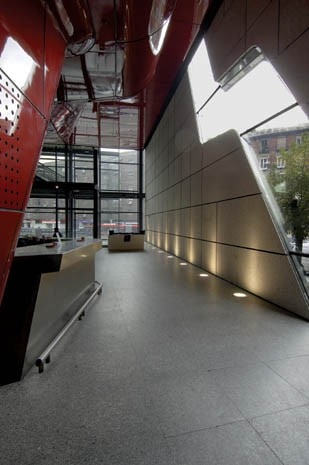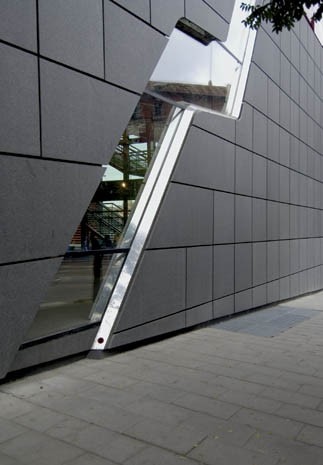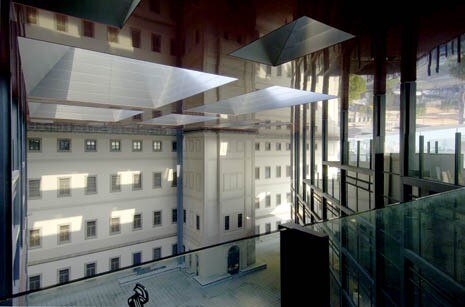Nouvel’s new factory
Luis Fernández-Galiano
The new Reina Sofía is a grand building but not a great work. A B-product of Nouvel’s factory, its lightweight aesthetic combines all the futuristic features that have made the French architect so popular: the industrial atmosphere of steel-and-glass constructions, a theatrical taste for bright and dark interiors, the dissolution of volume by sharp edges and reflective surfaces.
In hygienic contrast to the inert gravity of the 18-century hospital housing the existing museum, the extension groups together the new temporary exhibition galleries, the auditorium and the library beneath a floating, cherry-coloured canopy, which is sculpturally perforated to illuminate the spectacular central atrium. Lightened by transversal voids, translucent latticework and steel mirrors giving an immaterial air, the complex was built with cold passion and an analytical spirit on a tight trapezoidal lot adjoining the work of Sabatini. Future visitors standing on the terrace lookouts (if they are finally opened to the public) will also note its role as an urban hinge between the monumental silhouettes of Atocha Station on one hand, and the cluttered, folksy Lavapiés quarter on the other.
These are two landmarks of Madrid’s sentimental geography that were rendered inseparable by the bombs of 11 March 2004 – placed in four trains bound to Atocha Station by immigrants living in Lavapiés. A minor work of a major architect, the recently inaugurated enlargement has been affected by the institution’s poor management, regrettably distorting the public perception of the building. But it nonetheless shows the quality expected of leading brands, whether of automobiles or architectures. In the same way that buyers of luxury vehicles do not censure the continuity of the features on which their fidelity to the manufacturer is based, here the client should make no reproach if the weightless canopy comes from Marne-la-Vallée and Lucerne, the careening capotage from Tours, the framed latticework from Bezons, the industrial stairs from Nîmes, the slender columns from Nantes, or the glazed scaffoldings from the Cartier building in Paris.
The critic can only lament venial sins: the difficult agreement between stone claddings and enamelled metal curves, the hapless cut of the canopy where it meets Sabatini’s cornice, skylights in the upper exhibition gallery giving way to terraces for the offices, or the absence of the trees that were to be planted in the atrium so as to allow expanding the storage basements. Presided over by Brushstroke, a huge Lichtenstein sculpture on loan, this bleak atrium is beaten by the wind and filled with traffic noise that is deflected by the canopy and multiplied by the glass enclosures. It provides a second entry to the museum, giving access to the pompously denominated “Nouvel Space” without crossing through the old hospital. Via this atrium one also enters a warm, well-stocked bookstore which adequately overlooks the soaring void of the library, both of which are screened from the busy street by brise-soleils that do not entirely stop the sun from falling on the books. The atrium also leads to the café-restaurant under the cantilevered belly of the auditorium. Furnished with fanciful tables and counters by another architect, this area is particularly pleasing in the warped crack between the two volumes (never mind the restaurant tables getting lost in the dark) and frankly shocking in the horizontal projection of the auditorium profile on the facade, which ill-fatedly cuts the gridded granite cladding.
It is probably in this conflict between the technological reinterpretation of traditional stone construction and the cartoon version of science-fiction imagery where the project’s Achilles heel is to be found: the granite does not have the severe gravitas of institutional permanence, nor do the fuselages have the exact finish of aeronautical construction, and the cocktail blend is a curdled mayonnaise. Otherwise this red and black Nouvel – which won the 1999 competition against the likes of Dominique Perrault or Juan Navarro Baldeweg – places itself with dignity in the creative register of an architect who has managed to reconcile the seductive imagination of film, advertising or fashion with the French tradition of experimental engineering that stretches from Pierre Chareau to his master Jean Prouvé.
These mediatic and mechanic theatres are his distinctive trademark. In Madrid he has had the collaboration of Alberto Medem, a young architect who graduates to the major leagues with this work, carried out by the building company ACS-Dragados with only a 16% increase on the initial budget of 68 million euros. That seems something of a miracle considering the exigent geometry of the technical ceilings, the rigour of the facades, or the discipline of the details in this colossal construction.
From now on it will be subjected to the degree of public scrutiny that befits its function: accommodating the ceremonies of art. Art is now the State’s only religion and thus the object of much controversy where the election of its priests and the architecture of its churches are concerned. But no one will cry out that the Queen is naked.
Luis Fernández-Galiano (1950) is an architect and professor at Madrid’s School of Architecture. Editor of the magazines Arquitectura Viva and AV Monographs, he writes on architecture for Spain’s leading newspaper, El País
